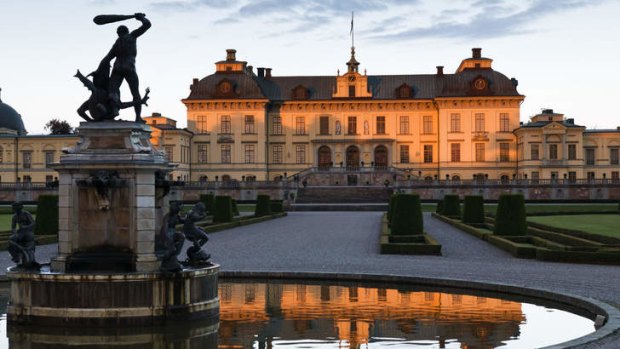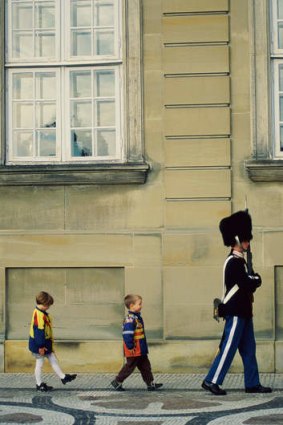
The Baroque gardens at Drottningholm Palace in Sweden.Credit: Getty Images
Scandinavians love and respect their royals Alison Stewart discovers, on a tour fit for a queen.
Denmark's royal guards warn off people who sit on the steps of Amalienborg Palace, Queen Margrethe II's Copenhagen residence. The much-loved queen insists, however, that the guards make an exception for local preschoolers who like to eat their play lunches there.
Crown Prince Frederik and his Australian-born Crown Princess Mary send their children, Christian and Isabella, to a public school, ferry them around Copenhagen's streets in an adult's tricycle like ordinary Danish parents, and Mary has been known to pop down for a chat when besotted Australian tourists call up, "Mary, we love you!"

Step this way: Amalienborg Square in Copenhagen, where children are encouraged to have fun.Credit: Getty Images
Norwegians voted their late King Olav V of Norway Norwegian of the century in 2005. The down-to-earth royal won hearts when he refused to drive during the 1973 oil crisis in solidarity with Norwegians, taking to the Oslo subway, his poodle on his lap.
When other European monarchies were falling like skittles after a slew of bloody revolutions, Scandinavia's royals kept their feet firmly on the ground to keep their heads firmly on their shoulders and they continue to do so.
And remarkably, the Nordic countries with their classless hybrid political systems that embrace capitalism but lean towards social democracy, wholeheartedly support their constitutional monarchies.
Despite the pomp and palaces, rich regalia and royal dynasties stretching back to Viking times, Scandinavian royals have cannily cultivated the common touch.
They mingle and are free with interviews, there are few aggressive paparazzi, high walls and over-the-top security and only the occasional republican mutterings, quickly quashed by the fact that Scandinavian royals earn their keep promoting their countries' business and trade.
Our two-week Tauck World Discovery journey through Sweden, Denmark and Norway sheds much light on the fairytale that is Royal Scandinavia. Stockholm is where we begin, Sweden's lovely capital on Lake Malaren.
Sweden regards itself as having one of the world's most stable and egalitarian democracies, with a monarchy that has deep roots and public support.
It shows a strong royal presence with its 11 state-owned palaces, all open to the public, plus the islands that were once royal hunting grounds or royal farms, now returned to the nation.
Swedish monarchs date back 1000 years and have belonged to 11 dynasties, with the current one, the House of Bernadotte, the longest reigning.
King Carl Gustav is the seventh monarch of that house.
Within walking distance is the Royal Palace or Kungliga Slott in central Stockholm, where the royals have their offices, one of Europe's largest palaces with 608 rooms. It's a lovely Baroque building in the Old Town, or Gamla Stan. The royal armoury has the stuffed horse and armour of Swedish warrior king Gustav II Adolf. The apartments of state boast beautiful interiors including Oscar II's writing room, left unchanged since his death in 1907.
The Crown Jewels and regalia, which belong to the state, not the royals, are displayed in the Skattkammaren, or royal treasury.
World Heritage-listed Drottningholm Palace is the home of the royal family, Sweden's best-preserved Renaissance royal palace. The 1753 Chinese Pavilion is lovely with its rococo furnishings in the chinoiserie style (and Queen Lovisa Ulrika's toilet is on display, proving for the doubters that royals are human too).
There's an imposing 1681 Baroque garden modelled on Versailles and the Drottningholm Palace Theatre is Europe's best preserved 18th-century theatre.
Out of Stockholm we roll, stopping for lunch at the 17th-century Lofstad Slott in Ostergotland, rebuilt in the 1750s by a nobleman reputed to be the lover of Marie Antoinette.
These many slott or castles are rather more like grand estates, built for Swedish nobility. Unlike Norway, which despite having a royal family, prides itself on being a deeply democratic country of fishermen and farmers, Sweden is a country with a historically flourishing aristocracy. Even nobles eat Swedish meatballs however, and that is what we have for lunch.
We're headed for Toftaholm, 362 kilometres south of Stockholm, a restored, allegedly haunted manor on the shores of Lake Vidostern in Smaland. This is a watery landscape of rolling green hills, apple, raspberry and cherry orchards. Toftaholm's history goes back to the 14th century, when its politically ambitious noble family, the Stenbocks began cultivating royalty. An ageing, rather smelly King Gustav Vasa married the reluctant 16-year-old Katarina Stenbock, who might have found a way to bump him off six years later.
The food is fit for a king in Toftaholm, a member of the Historic Hotels of Sweden and we sleep deeply, unlike the unfortunate couple assigned to the "haunted" room where a lovelorn lackey hanged himself.
Heading further south towards the Oresund Bridge, which links Sweden with Denmark, we stop at Sofiero Slott, a gardener's heaven, voted Europe's Best Park in 2010. This charming palace, a wedding gift in 1864, was a royal summer residence until 1973 when King Gustav VI Adolf bequeathed it to the city of Helsingborg.
King Gustav Adolf and his two English queens - Queen Victoria's granddaughter Margareta and then Lady Louise Mountbatten - shared a passion for gardening. There are more than 10,000 precious rhododendrons planted in 1907, a historic fruit orchard, "flower highway", Victorian kitchen garden and fragrant garden, also Scandinavia's largest dahlia plantation.
The king actively encouraged people to walk on the grass and the current Queen Silvia (a commoner like a number of Scandinavian royal consorts) likes local children to grow strawberries in the prince and princesses playhouses. Helsingborg repays the queen with love, and a giant flower jewel at Sofiero's entrance for her 50th birthday present.
In keeping with democratic principles, King Gustav Adolf, who received many heads of state in the Royal Football Ground (which looks across to Denmark's Kronborg Castle, immortalised as Hamlet's Elsinore) always greeted them simply. Then United States vice-president Lyndon Johnson was put out - he wanted pomp, or at least children with flags.
It's time to leave Sweden and we cross from Malmo into Copen-hagen. Denmark, with its all-powerful kings, is a salutary example of how the royals gave up their absolute power in the interests of self-preservation.
By 1849, Frederik VII participated willingly in the democratic process. Danes, sick of being treated like slaves, demanded changes, unhappy at royal shenanigans during the Baroque period from 1600 to 1750.
Something was clearly rotten in the state of Denmark when high-handed acts were de rigueur. Christian IV, for example, though educated and civilised, was still a bit of a megalomaniac. Styling himself as Neptune, god of the sea (see the fountain at Frederiksborg Castle), he imprisoned his second queen, Kirsten Munk for refusing sex after bearing him 12 children in 14 years. She never saw her children again.
Christian V razed a town to extend the royal hunting grounds and deer park at Eremitage near Copenhagen.
The Baroque kings had absolute control over even nature. The current Queen Margrethe has redesigned Frederiksborg's Baroque-style gardens, according to our guide, because Danes did not like the reminder.
Two standout Danish palaces are the fairytale Dutch Renaissance Rosenborg Castle in Copenhagen and the equally gorgeous Frederiksborg Castle, an hour from Copenhagen in the market town of Hillerod.
Both are now museums, Frederiksborg being the pride of Denmark's castles, now housing the Museum of National History whose contents illuminate Danish history and are in their own way deeply democratic - the historical paintings were placed chronologically so that even the illiterate could understand their history.
The beautiful palace chapel, where Crown Prince Ferderik's brother Joachim (known as "the chicken farmer") was married, is now available for marriage ceremonies for all who live in the local community.
Rosenborg Castle was Christian IV's summer castle 400 years ago but was opened to the public in 1838. Collections are arranged chronologically giving an overall picture of Denmark's history, effectively Europe's first museum of contemporary culture.
In the Long Hall, with its beautiful tapestries, look out for the king's throne made of unicorn horn (narwhal tusk) and the queen's silver throne guarded by three silver lions.
Also Christian IV's entertainment chair, which restrains its occupant, floods his trousers, then toots, farts, makes wee-ing sounds and generally must have mightily contributed to the hilarity of the absolute monarch.
Next stop is Norway, where we learn that while the Norwegian monarchy dates back to Viking times, the country was more often than not ruled by Swedish or Danish kings.
It was only in 1905, when Norway gained its independence from Sweden and, despite calls to declare a republic, voted for a constitutional monarchy.
They asked the Danish Prince Carl to be their king. He agreed, changed his name to Haakon VII and his son Alexander's to Olav, who became the beloved Olav V.
For Norwegians, the coronation and re-establishment of the monarchy ironically represented the return to a free and independent Norway.
A drive past the royal lodgings in Oslo reveals an almost hilarious lack of security - one guard shivering in the rain beside a fence.
With various hiccups along the way, Scandinavia's royals have learnt their lesson well.
As Denmark's Frederik recently said, "The main thing [is] to move with the times, find out the lie of the land and be influenced by what you find, and shape the institution on that basis".
Before mounting his tricycle and riding his kids off to school.
The writer was a guest of Travel the World.
GETTING THERE
Thai Airways has a fare to Stockholm for about $1950 return from Sydney and Melbourne including tax. Fly to Bangkok (about 9hr) and then to Stockholm (11hr 20min); see thaiairways.com.au.
TOURING THERE
Travel the World has a 14-day Tauck World Discovery Scandinavia journey by motorcoach and overnight ferry through Sweden, Denmark and Norway. Includes hotels, most meals, guides, admission fees, diverse excursions. The tour explores Scandinavian royalty, among other themes. From $US5690 ($6050) a person. Phone 1300 857 437, see traveltheworld.com.au.
TRIP NOTES MORE INFORMATION
Sign up for the Traveller Deals newsletter
Get exclusive travel deals delivered straight to your inbox. Sign up now.